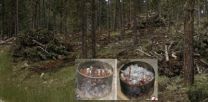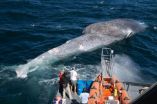(Press-News.org) RIVERSIDE, Calif. -- To reduce fire hazard in the United States, wildland managers often utilize the silvicultural practice of mechanically cutting woody shrubs and suppressed trees (ladder fuels). These cuttings and other post-logging debris are then burned during periods of low fire danger in order to dispose of the material. To improve the burning and minimize hazardous air pollutants, managers often cover all or part of the debris pile with low-density polyethylene plastic, commonly referred to as agricultural plastic, in order to keep water out. A recent study published in the Journal of the Air and Water Association shows that inclusion of agricultural plastic in debris piles has no effect on smoke emissions.
Co-author Dr. David Weise, research forester from the U.S. Forest Service Pacific Southwest Research Station at Riverside, Calif., designed and conducted this study with a team of scientists from the University of California Riverside College of Engineering to examine if agricultural plastic covers affect smoke emissions from burning piles thus having an additional impact on air quality beyond that of wood smoke.
The controlled laboratory study simulated debris piles that contained agricultural plastic in varying amounts to see if they could detect an effect. Burning conditions were optimal because the wood was very dry which encouraged good burning. The scientists added up to 25 times the amount of agricultural plastic found in normal piles and used state of the art real-time instruments to measure the gaseous and particulate emissions. After analyzing the measurements, they did not detect differences in the emissions for the vast majority of compounds they measured.
Based on the results of this and previous studies and literature reviews, including the small amount of agricultural plastic in silvicultural debris piles as is currently practiced does not appear to affect the emissions produced under optimal burning conditions. "This study supports the hypothesis put forth a decade ago that burning agricultural plastic in debris piles would not add significantly to the emissions from a debris pile. We still need to conduct experiments to determine if there is an improvement in burning efficiency beyond simply keeping the piles dry." Dr. Weise said.
This research provides a key piece of information for wildland managers using on site burning to dispose of accumulated forest debris in a safe manner under favorable conditions with limited impact on air quality, visibility and human health.
INFORMATION:
Read the full article: http://www.treesearch.fs.fed.us/pubs/45923
Headquartered in Albany, Calif., the Pacific Southwest Research Station develops and communicates science needed to sustain forest ecosystems and other benefits to society. It has research facilities in California, Hawaii and the U.S.–affiliated Pacific Islands. For more information, visit http://www.fs.fed.us/psw/.
Study gives new perspective on agricultural plastic, debris burning, and air quality
2014-07-24
ELSE PRESS RELEASES FROM THIS DATE:
Age of puberty in girls influenced by which parent their genes are inherited from
2014-07-24
(Boston)--The age at which girls reach sexual maturity is influenced by 'imprinted' genes, a small sub-set of genes whose activity differs depending on which parent passes on that gene, according to new research published today in the journal Nature.
The findings come from an international study of more than 180,000 women involving scientists from 166 institutions worldwide, including Boston University School of Medicine. The researchers identified 123 genetic variations that were associated with the timing of when girls experienced their first menstrual cycle by analysing ...
15-year analysis of blue whale range off California finds conflict with shipping lanes
2014-07-24
NEWPORT, Ore. -- A comprehensive 15-year analysis of the movements of satellite-tagged blue whales off the West Coast of the United States found that their favored feeding areas are bisected by heavily used shipping lanes, increasing the threat of injury and mortality.
The researchers note that moving the shipping lanes off Los Angeles and San Francisco to slightly different areas – at least, during summer and fall when blue whales are most abundant – could significantly decrease the probability of ships striking the whales. A similar relocation of shipping lanes in the ...
Greater odds of adverse childhood experiences in those with military service
2014-07-24
Bottom Line: Men and women who have served in the military have a higher prevalence of adverse childhood events (ACEs), suggesting that enlistment may be a way to escape adversity for some.
Authors: John R. Blosnich, Ph.D., M.P.H., of the Veterans Affairs Pittsburgh Healthcare System, and colleagues.
Background: The prevalence of ACEs among U.S. military members and veterans is largely unknown. ACEs can result in severe adult health consequences such as posttraumatic stress disorder, substance use and attempted suicide.
How the Study Was Conducted: Authors compared ...
Enhanced recovery program following colorectal surgery at community hospitals
2014-07-24
Bottom Line: An enhanced recovery program for patients after colorectal surgery appears to be feasible in a community hospital setting after having been shown to be successful in international and academic medical centers.
Author: Cristina B. Geltzeiler, M.D., of Oregon Health and Science University, Portland, and colleagues.
Background: The fundamental aspects of enhanced recovery after surgery (ERAS) programs are guidelines that focus on patient education, optimal fluid management, minimal incision length, decreased use of tubes and drains, opioid-sparing analgesia, ...
Study examines postoperative pneumonia prevention program in surgical ward
2014-07-24
Bottom Line: A postoperative pneumonia prevention program for patients in the surgical ward at a California Veterans Affairs hospital lowered the case rate for the condition, which can cause significant complications and increase the cost of care.
Author: Hadiza S. Kazaure, M.D., of the Stanford University School of Medicine, California, and colleagues.
Background: Pneumonia is a common infection that accounts for about 15 percent of all hospital-acquired infections and as much as 3.4 percent of complications among surgical patients.
How the Study Was Conducted: The ...
New regions of genetic material are involved in the development of colon cancer
2014-07-24
Most research on human cancer genes have been focused on the regions of the coding genome (exons) that are to be translated in the form of amino acids thus proteins. But just before each gene, there is a regulatory region or activator which controls the expression and activity of the adjacent gene. Until now, very little was known of the role exerted such DNA fragment in tumor development.
An article published today in Nature in collaboration with the group of Manel Esteller, Director of Epigenetics and Cancer Biology, Bellvitge Biomedical Research Institute (IDIBELL), ...
Nano-sized chip 'sniffs out' explosives far better than trained dogs
2014-07-24
Security forces worldwide rely on sophisticated equipment, trained personnel, and detection dogs to safeguard airports and other public areas against terrorist attacks. A revolutionary new electronic chip with nano-sized chemical sensors is about to make their job much easier.
The groundbreaking nanotechnology-inspired sensor, devised by Prof. Fernando Patolsky of Tel Aviv University 's School of Chemistry and Center for Nanoscience and Nanotechnology, and developed by the Herzliya company Tracense, picks up the scent of explosives molecules better than a detection dog's ...
Detecting concussion-related brain disease in its earliest stages
2014-07-24
Autopsies have shown that some high-profile athletes who suffered repeated blows to the head during their careers have unusual protein clumps in their brains. Those clumps suggest the athletes had a disease called chronic traumatic encephalopathy (CTE). Now, scientists are working on tests that might be able to detect CTE in its earliest stages, according to an article in Chemical & Engineering News (C&EN), the weekly news magazine of the American Chemical Society.
In the article, Lauren Wolf, a senior editor at C&EN, explains that many of these athletes struggled with ...
Dead-body-feeding larvae useful in forensic investigations
2014-07-24
VIDEO:
This image depicts Chrysomya megacephala larvae on decomposing fish.
Click here for more information.
Non-biting blow fly Chrysomya megacephala is commonly found in dead bodies and is used in forensic investigations to determine the time of death, referred to as the post mortem interval. A report of synanthropic derived form of C. megacephala from Tamil Nadu is provided for the first time based on morphological features and molecular characterization through generation ...
Nearly 50 years of lemur data now available online
2014-07-24
VIDEO:
Duke Lemur Center had made 48 years of primate data available online.
Click here for more information.
DURHAM, N.C. -- A 48-year archive of life history data for the world's largest and most diverse collection of endangered primates is now digital and available online. The Duke Lemur Center database allows visitors to view and download data for more than 3600 animals representing 27 species of lemurs, lorises and galagos -- distant primate cousins who predate monkeys ...



